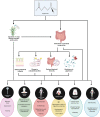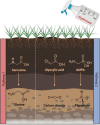Impact of glyphosate (RoundupTM) on the composition and functionality of the gut microbiome
- PMID: 38099711
- PMCID: PMC10561581
- DOI: 10.1080/19490976.2023.2263935
Impact of glyphosate (RoundupTM) on the composition and functionality of the gut microbiome
Abstract
Glyphosate, the active ingredient in the broad-spectrum herbicide RoundupTM, has been a topic of discussion for decades due to contradictory reports of the effect of glyphosate on human health. Glyphosate inhibits the enzyme 5-enolpyruvylshikimate-3-phosphate synthase (EPSPS) of the shikimic pathway producing aromatic amino acids in plants, a mechanism that suggests that the herbicide would not affect humans as this pathway is not found in mammals. However, numerous studies have implicated glyphosate exposure in the manifestation of a variety of disorders in the human body. This review specifically outlines the potential effect of glyphosate exposure on the composition and functionality of the gut microbiome. Evidence has been building behind the hypothesis that the composition of each individual gut microbiota significantly impacts health. For this reason, the potential of glyphosate to inhibit the growth of beneficial microbes in the gut or alter their functionality is an important topic that warrants further consideration.
Keywords: Glyphosate; RoundupTM; antimicrobial; gut microbiome; human health.
Conflict of interest statement
No potential conflict of interest was reported by the author(s).
Figures




Similar articles
-
Classification of the glyphosate target enzyme (5-enolpyruvylshikimate-3-phosphate synthase) for assessing sensitivity of organisms to the herbicide.J Hazard Mater. 2021 Apr 15;408:124556. doi: 10.1016/j.jhazmat.2020.124556. Epub 2020 Nov 14. J Hazard Mater. 2021. PMID: 33243645
-
Use of Shotgun Metagenomics and Metabolomics to Evaluate the Impact of Glyphosate or Roundup MON 52276 on the Gut Microbiota and Serum Metabolome of Sprague-Dawley Rats.Environ Health Perspect. 2021 Jan;129(1):17005. doi: 10.1289/EHP6990. Epub 2021 Jan 27. Environ Health Perspect. 2021. PMID: 33502259 Free PMC article.
-
The Ramazzini Institute 13-week pilot study on glyphosate and Roundup administered at human-equivalent dose to Sprague Dawley rats: effects on the microbiome.Environ Health. 2018 May 29;17(1):50. doi: 10.1186/s12940-018-0394-x. Environ Health. 2018. PMID: 29843725 Free PMC article.
-
Effects of glyphosate and glyphosate-based herbicides like Roundup™ on the mammalian nervous system: A review.Environ Res. 2022 Nov;214(Pt 4):113933. doi: 10.1016/j.envres.2022.113933. Epub 2022 Jul 19. Environ Res. 2022. PMID: 35868581 Review.
-
Safety evaluation and risk assessment of the herbicide Roundup and its active ingredient, glyphosate, for humans.Regul Toxicol Pharmacol. 2000 Apr;31(2 Pt 1):117-65. doi: 10.1006/rtph.1999.1371. Regul Toxicol Pharmacol. 2000. PMID: 10854122 Review.
Cited by
-
The Significance of Plant Nutrition in the Creation of the Intestinal Microbiota-Prevention of Chronic Diseases: A Narrative Review.Medicina (Kaunas). 2024 Nov 29;60(12):1969. doi: 10.3390/medicina60121969. Medicina (Kaunas). 2024. PMID: 39768848 Free PMC article. Review.
-
The Microbiota in Cancer: A Secondary Player or a Protagonist?Curr Issues Mol Biol. 2024 Jul 23;46(8):7812-7831. doi: 10.3390/cimb46080463. Curr Issues Mol Biol. 2024. PMID: 39194680 Free PMC article. Review.
-
Examining Sound, Light, and Vibrations as Tools to Manage Microbes and Support Holobionts, Ecosystems, and Technologies.Microorganisms. 2024 Apr 30;12(5):905. doi: 10.3390/microorganisms12050905. Microorganisms. 2024. PMID: 38792734 Free PMC article. Review.
-
Impact of Diquat on the Intestinal Health and the Composition and Function of the Gut Microbiome.Antioxidants (Basel). 2025 Jun 12;14(6):721. doi: 10.3390/antiox14060721. Antioxidants (Basel). 2025. PMID: 40563352 Free PMC article. Review.
-
Association Between Urinary Glyphosate Concentrations and Chronic Obstructive Pulmonary Disease in USA Participants: Evidence from NHANES 2013-2018.Int J Chron Obstruct Pulmon Dis. 2025 Mar 31;20:883-894. doi: 10.2147/COPD.S500429. eCollection 2025. Int J Chron Obstruct Pulmon Dis. 2025. PMID: 40191266 Free PMC article.
References
-
- Hawkins C., and Hanson C. Glyphosate: response to comments, usage and benefits. Office of Chemical Safety and Pollution Prevention; 2019.
-
- Do MH, Florea A, Farre C, Bonhomme A, Bessueille F, Vocanson F, Tran-Thi N, Jaffrezic-Renault N. Molecularly imprinted polymer-based electrochemical sensor for the sensitive detection of glyphosate herbicide. Int J Environ Anal Chem. 2015;95(15):1489–1501. doi: 10.1080/03067319.2015.1114109. - DOI
Publication types
MeSH terms
Substances
Grants and funding
LinkOut - more resources
Full Text Sources
